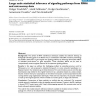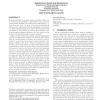181 search results - page 35 / 37 » Reverse Engineering Method Stereotypes |
ALMOB
2006
13 years 5 months ago
2006
Background: Bifurcation analysis has proven to be a powerful method for understanding the qualitative behavior of gene regulatory networks. In addition to the more traditional for...
BMCBI
2010
13 years 5 months ago
2010
Background: Oligonucleotide arrays have become one of the most widely used high-throughput tools in biology. Due to their sensitivity to experimental conditions, normalization is ...
BMCBI
2007
13 years 5 months ago
2007
Background: The advent of RNA interference techniques enables the selective silencing of biologically interesting genes in an efficient way. In combination with DNA microarray tec...
BMCBI
2010
13 years 5 months ago
2010
Background: The evolution of high throughput technologies that measure gene expression levels has created a data base for inferring GRNs (a process also known as reverse engineeri...
SASN
2006
ACM
13 years 11 months ago
2006
ACM
A great challenge in securing sensor networks is that sensor nodes can be physically compromised. Once a node is compromised, attackers can retrieve secret information (e.g. keys)...


